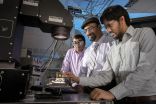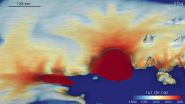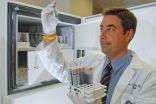INFORMATION:
The research was funded by the U.S. Department of Energy through DOE's Center for Re-Defining Photovoltaic Efficiency through Molecule Scale Control, the National Science Foundation's Network for Computational Nanotechnology, and the U.S. Air Force Office of Scientific Research.
Writer: Emil Venere, 765-494-4709, venere@purdue.edu
Source: Muhammad Ashraful Alam, 765 49-45988, alam@purdue.edu
Bryan Boudouris, 765-496-6056, boudouris@purdue.edu
PHOTO CAPTION:
Doctoral student Aditya G. Baradwaj (at left), professor Muhammad A. Alam (center) and doctoral student Ryyan Khan, operate a solar simulator. They are members of a research team led by former doctoral student Biswajit Ray and also involving assistant professor Bryan Boudouris reporting new findings that contradict a fundamental assumption about the functioning of "organic" solar cells made of low-cost plastics. The findings suggest a new strategy for creating inexpensive solar technology. (Purdue University image/John Underwood)
A publication-quality image is available at http://news.uns.purdue.edu/images/2015/alam-solar.jpg
ABSTRACT
Collection-limited Theory Interprets the Extra-ordinary Response of Single Semiconductor Organic Solar Cells
Biswajit Ray1*, Aditya G. Baradwaj2, M. Ryyan Khan1, Bryan W. Boudouris2, and Muhammad A. Alam1*
1 School of Electrical and Computer Engineering and Birck Nanotechnology Center, Purdue University
1School of Electrical and Computer Engineering, Purdue University, West Lafayette, IN 47907 2School of Chemical Engineering, Purdue University
* To whom correspondence should be addressed: alam@purdue.edu
The bulk heterojunction organic photovoltaic (OPV) architecture has dominated the literature due to its ability to be implemented in devices with relatively high efficiency values. However, a simpler device architecture based on a single organic semiconductor (SS-OPV) offers several advantages: it obviates the need to control the highly system-dependent nanoscale BHJ morphology, and therefore, would allow the use of broader range of organic semiconductors. Unfortunately, the photocurrent in standard SS-OPV devices is typically very low, which generally is attributed to inefficient charge separation of the photogenerated excitons. Here we show that the short-circuit current density from SS- OPV devices can be enhanced significantly (~100-fold) through the use of inverted device configurations, relative to a standard OPV device architecture. This result suggests that charge generation may not be the performance bottleneck in OPV device operation. Instead, we find that poor charge collection, caused by a defect-induced electric field screening, can be explained as the primary performance bottleneck in regular-geometry SS-OPV cells. We justify this hypothesis through performing: (1) detailed numerical simulations, (2) electrical characterization experiments of functional SS-OPV devices using multiple polymers (P3HT, MEH-PPV, PQT-12, etc.) as active layer materials, and (3) detailed impedance spectroscopy measurements. Furthermore, we show that the collection-limited photocurrent theory consistently interprets typical characteristics of regular SS-OPV devices. These insights should encourage the design and OPV-implementation of high purity, high mobility polymers, and other soft materials that have shown promise in organic field-effect transistor (OFET) applications, but have not performed well in bulk heterojunction OPV devices, wherein they adopt less-than-ideal nanostructures when blended with electron-accepting materials.
Challenge to classic theory of 'organic' solar cells could improve efficiency
2015-08-18
(Press-News.org) WEST LAFAYETTE, Ind. - New research findings contradict a fundamental assumption about the functioning of "organic" solar cells made of low-cost plastics, suggesting a new strategy for creating inexpensive solar technology.
Commercialization of organic solar cells has been hindered by inefficiencies, but the findings point toward a potential path to create a new class of solar technology able to compete with standard silicon cells.
"These solar cells could provide a huge cost advantage over silicon," said Muhammad Ashraful Alam, Purdue University's Jai N. Gupta Professor of Electrical and Computer Engineering.
Plastic solar cells might be manufactured using a roll-to-roll process similar to newspaper printing.
"This has been the hope for the last 20-25 years," said Bryan Boudouris, an assistant professor of chemical engineering.
Because organic solar cells are flexible they could find new applications that are unsuitable for rigid silicon cells such as photovoltaics integrated into buildings, and they have the potential to be lower-cost and less energy-intensive to manufacture than silicon devices. However, a critical bottleneck has prevented development of organic solar cells efficient enough to compete with silicon solar technology.
"Now it appears there is no fundamental reason why organic cells have to be less efficient than silicon," Alam said.
Findings are detailed in a research paper appearing this week (Aug. 17) in Proceedings of the National Academy of Sciences. The work was spearheaded by former doctoral student Biswajit Ray, who has graduated.
"Biswajit had the courage, conviction, and persistence to do a series of difficult experiments, and was ably supported at various stages by doctoral students Aditya Baradwaj and Ryyan Khan," Alam said.
The paper was authored by Ray, Baradwaj, Khan, Boudouris and Alam.
The primary bottleneck to more efficient organic solar cells is rooted in the fundamental workings of the organic photovoltaic technology. As the semiconducting material is illuminated with light, electrons move from one energy level to another. Due to the atomic structure, the electrons in the semiconductor occupy a region of energy called the "valence band" while the material is in the dark. But shining light on the material causes the electrons to absorb energy, elevating them into a region of higher energy called the "conduction band." As the electrons move to the conduction band they leave behind "holes" in the valance band, generating so-called electron-hole pairs in the plastic solar cells called excitons.
"Because the electron is negatively charged and the hole is positively charged, they like each other so much that they orbit around each other," Ray said. "You have to keep these two separated or they will recombine and you will not generate current."
This "charge separation" is maintained by inserting numerous structures called bulk heterojunctions, a design that has been a challenge to manufacture in a high-speed, large-scale and reproducible manner.
"You can think of these heterojunctions almost like knives cutting through the material to separate the electrons and holes," Alam said. "These heterojunctions have to be distributed throughout so that no matter where the electron-hole pair is generated you can cut them."
This requirement limits the efficiency of organic solar cells, a bottleneck established by research more than two decades ago. However, Ray showed through detailed computational modeling that a fundamental assumption about the organic solar cells was incorrect, eliminating the need for heterojunctions.
"He kept saying he didn't need to invoke excitons in order to explain many of the experimental results," Alam said. "It turns out that the original experiment was misinterpreted."
This misinterpretation arises from the design of organic cells. The cells have two metal contacts, one on top and one on the bottom of the device, and each is made of different types of metal. Because of this configuration, incoming sunlight generates an electric field concentrated at the bottom of the cell, which allows the electron-hole pairs to readily recombine. Ray proposed flipping the contacts so that the electric field forms at the top of the cell instead of at the bottom, allowing for better charge separation.
"He inverted the structure and explained that the inefficiency is taking place because the electron-hole pairs are not staying separated," Alam said.
Simulations showed flipping the configuration allowed for better charge separation and higher efficiency, and then laboratory experiments by Ray, Baradwaj and Khan validated the new concept.
The findings also suggest the design of organic solar cells can be simplified, representing a major potential innovation, Ray said. Whereas conventional organic solar cells are made by mixing two types of polymers, the new design requires only one polymer.
"Currently, you have to design the solar cells according to how well two organic materials mix together in order to produce these numerous heterojunctions," Boudouris said. "But if you only needed one polymer instead of two, the manufacturability on the large scale could be very much improved, so this is an exciting development."
Findings also suggest that producing the cells out of purer polymers could result in more efficient solar cells, and the research likely will lead to a better understanding of the physics of how organic solar cells operate, Alam said.
Much of the experimental work was performed in the Purdue Solar Energy Utilization Laboratory, formed with funds from the National Science Foundation, which allows specialists from different fields to collaborate. The research is ongoing, and Khan will continue to work on a new class of solar cells that do not require bulk heterojunctions.
ELSE PRESS RELEASES FROM THIS DATE:
Most comprehensive projections for West Antarctica's future revealed
2015-08-18
A new international study is the first to use a high-resolution, large-scale computer model to estimate how much ice the West Antarctic Ice Sheet could lose over the next couple of centuries, and how much that could add to sea-level rise. The results paint a clearer picture of West Antarctica's future than was previously possible. The study is published today (18 August) in The Cryosphere, an open access journal of the European Geosciences Union (EGU).
"The IPCC's [Intergovernmental Panel on Climate Change] 4th and 5th Assessment Reports both note that the acceleration ...
Possible test for liver cancer using technology for analysing rocks and minerals
2015-08-18
A group of clinicians and geochemists are working to develop a test for the most common form of primary liver cancer, HCC (Hepatocellular Carcinoma). HCC kills over 600,000 people worldwide every year. It usually develops from chronic liver disease such as hepatitis or cirrhosis, but there is no good biochemical test to indicate when the cancer develops, meaning that even for patients most at risk, it is nearly impossible to know when a cancer may develop until symptoms appear. Now a multi-national group of scientists are developing a new test for HCC, based on methods ...
How having racially diverse friends can help you on the job
2015-08-18
COLUMBUS, Ohio - Employees with a racially diverse group of friends outside of work may actually perform better at their jobs, a new study suggests.
Researchers found that workers who had more different-race friends in their personal lives than their co-workers also tended to have a more racially diverse network of friends on the job. This broader network was linked to employees who did more tasks beyond their job responsibilities and who, under certain circumstances, had more trust in their supervisors.
"Your friends outside of work actually have this connection to ...
Frequency of family meals increased by a new school presentation
2015-08-18
This news release is available in French. This news release is available in French. New research shows that teaching young adolescents practical cooking skills leads to positive changes for the entire family. In an article published today in Applied Physiology, Nutrition, and Metabolism, an NRC Research Press journal (a division of Canadian Science Publishing), researchers evaluated the Kinect-Ed presentation and found an increase in the frequency of family dinners after participation.
Kinect-Ed, a 90-minute motivational nutrition education presentation, was ...
Powdered cranberry combats colon cancer in mice
2015-08-18
BOSTON, Aug. 18, 2015 -- Cranberries are often touted as a way to protect against urinary tract infections, but that may be just the beginning. Researchers fed cranberry extracts to mice with colon cancer and found that the tumors diminished in size and number. Identifying the therapeutic molecules in the tart fruit could lead to a better understanding of its anti-cancer potential, they say.
The team will describe their approach in one of more than 9,000 presentations at the 250th National Meeting & Exposition of the American Chemical Society (ACS), the world's largest ...
Solar cell efficiency could double with novel 'green' antenna
2015-08-18
BOSTON, Aug. 18, 2015 -- The use of solar energy in the U.S. is growing, but panels on rooftops are still a rare sight. They cost thousands of dollars, and homeowners don't recoup costs for years even in the sunniest or best-subsidized locales. But scientists may have a solution. They report today the development of a unique, "green" antenna that could potentially double the efficiencies of certain kinds of solar cells and make them more affordable.
The researchers are presenting their work at the 250th National Meeting & Exposition of the American Chemical Society (ACS). ...
IU School of Medicine researchers report biomarkers and apps that predict risk of suicide
2015-08-18
INDIANAPOLIS -- People being treated for bipolar disorder and other psychiatric illnesses are at greater risk of attempting suicide, but physicians may now have tools to predict which of those individuals will attempt it and intervene early to prevent such tragedies from occurring.
Researchers at Indiana University School of Medicine reported Tuesday in the Nature Publishing Group's leading journal in psychiatry, Molecular Psychiatry, that they have developed blood tests and questionnaire instruments that can predict with more than 90 percent accuracy which of those patients ...
'Molecular tweezer' targets HIV and prevents semen from promoting infection
2015-08-18
An unprecedented potential "molecular tweezer" called CLR01, reported in the journal eLife, not only blocks HIV and other sexually transmitted viruses, but also breaks up proteins in semen that boost infection.
Semen is the main vector for sexual HIV transmission. It contains proteins that assemble into very stable polymers called amyloid fibrils, which can enhance HIV infectivity by up to 10,000 times. Scientists led by the University of Pennsylvania (USA) and Ulm (Germany) now show that a molecule with the shape of a tweezer not only destroys HIV particles but also ...
Meteorite impacts can create DNA building blocks
2015-08-18
A new study shown that meteorite impacts on ancient oceans may have created nucleobases and amino acids. Researchers from Tohoku University, National Institute for Materials Science and Hiroshima University discovered this after conducting impact experiments simulating a meteorite hitting an ancient ocean (Fig. 1).
With precise analysis of the products recovered after impacts, the team found the formation of nucleobases and amino acids from inorganic compounds. The research is reported this week in the journal Earth and Planetary Science Letters.
All the genetic information ...
Two-year-olds with larger oral vocabularies enter kindergarten better prepared
2015-08-18
Children with better academic and behavioral functioning when they start kindergarten often have better educational and societal opportunities as they grow up. For instance, children entering kindergarten with higher reading and math achievement are more likely to go to college, own homes, be married, and live in higher-income neighborhoods as adults. Now a new study points to very early roots of differences in school readiness, with growth in vocabulary playing a particularly important role. The study found that children with larger oral vocabularies by age 2 arrived at ...



